-
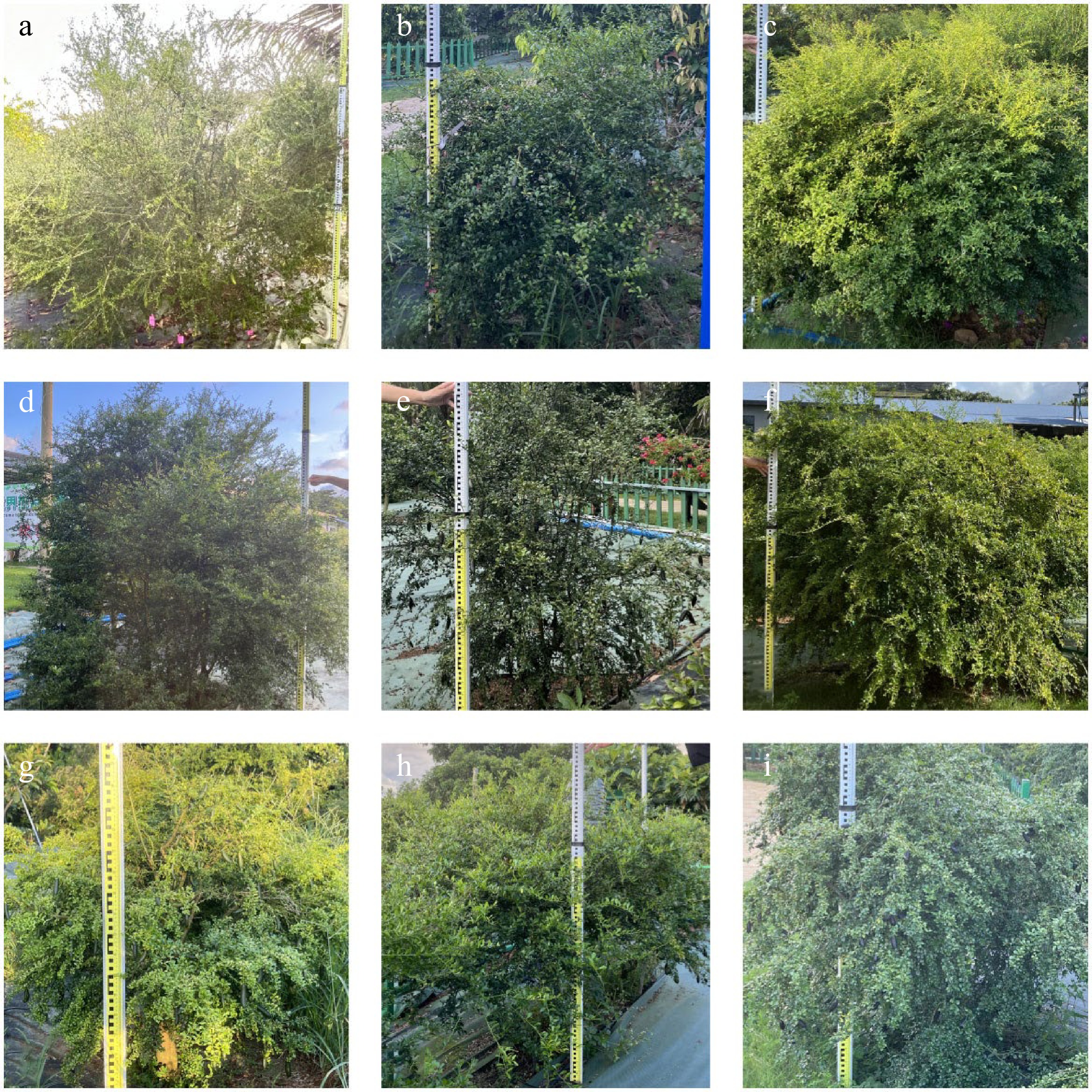
Figure 1.
Appearance of the nine finger lime varieties: (a) Hongbaoshi, (b) Lvbaoshi, (c) Lvshuijing, (d) Meiweilv, (e) Wokepu, (f) Xiangbinhong, (g) Xiaolubi, (h) Xuemeng, (i) Yaoji.
-

Figure 2.
Comparison of leaf shape characteristics of different finger lime varieties (left to right: Meiweilv, Xiangbinhong, Yaoji, Wokepu, Hongbaoshi, Lvbaoshi, Xuemeng, Lvshuijing, Xiaolubi).
-
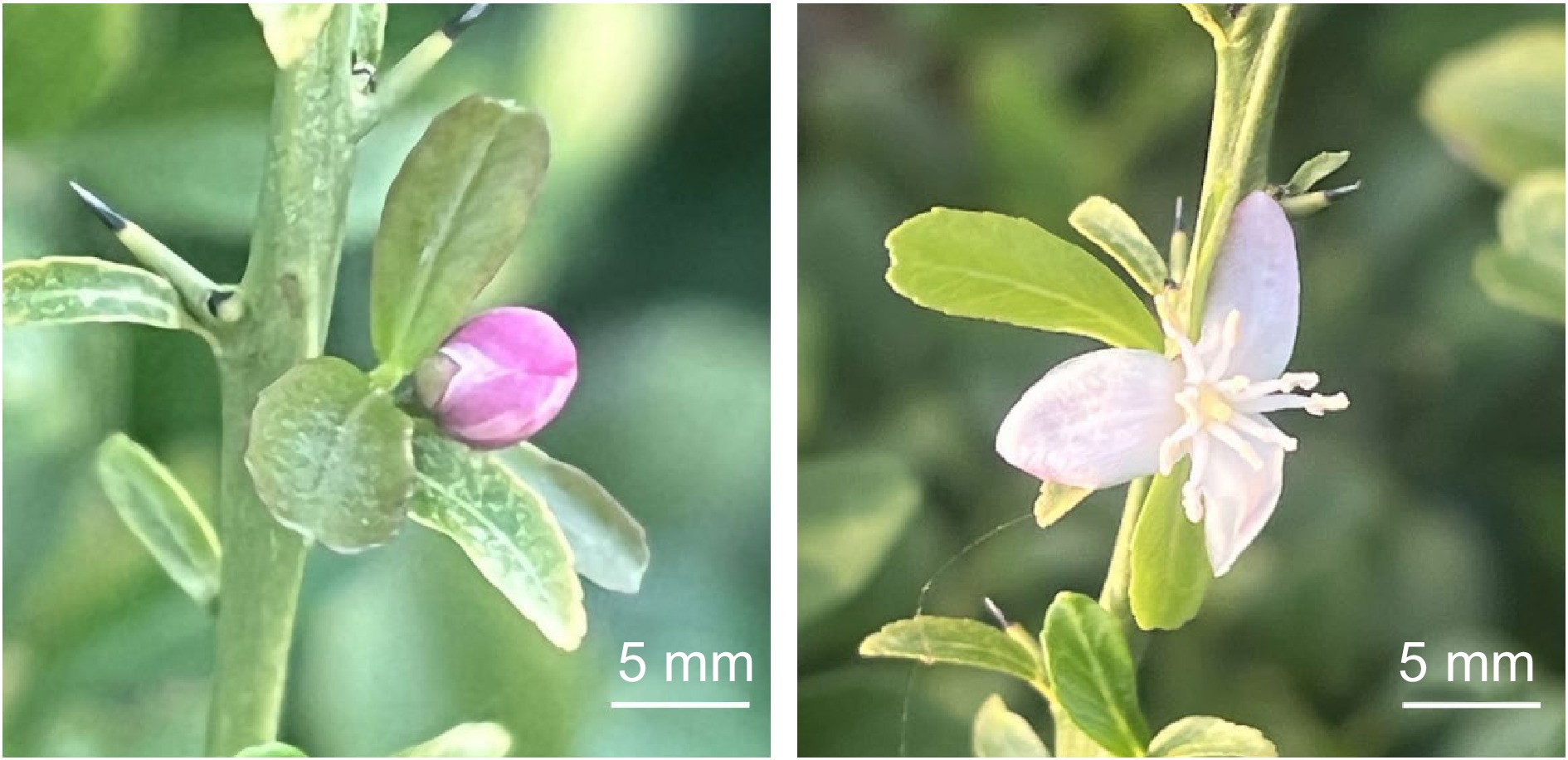
Figure 3.
Appearance of the finger lime flower during budding (left) and flowering (right).
-
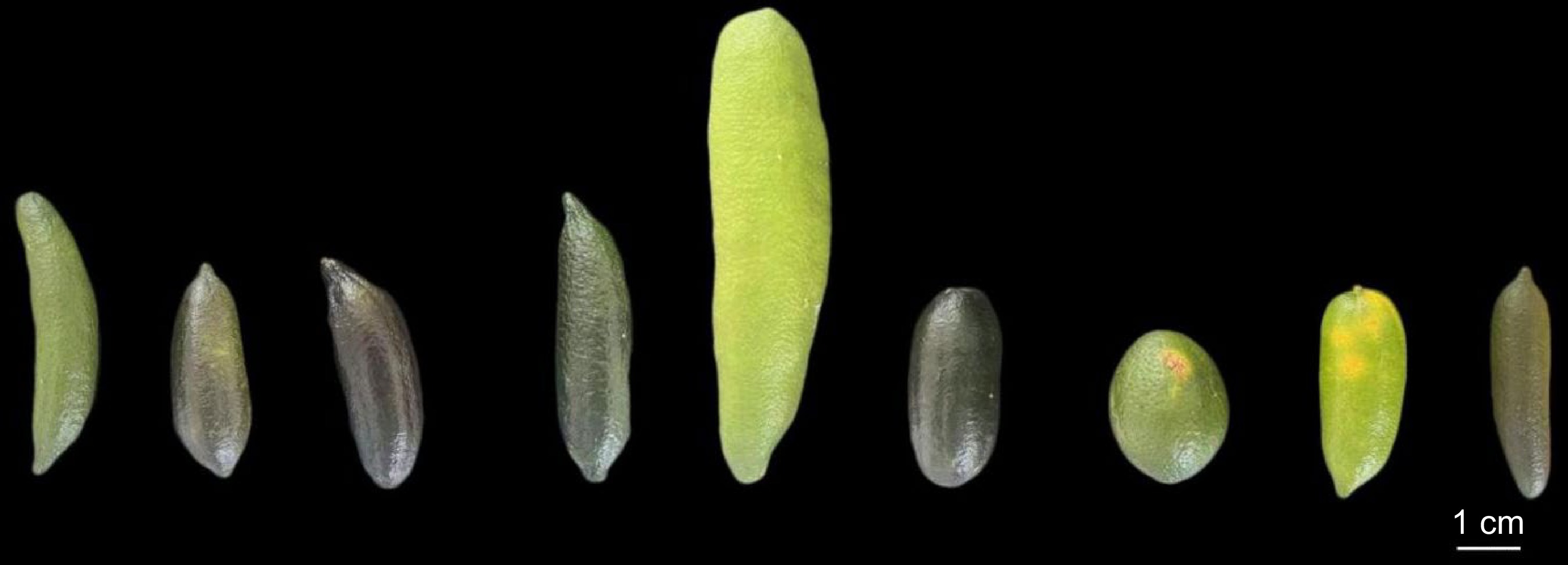
Figure 4.
Comparison of fruit shape characteristics of different finger lime varieties (left to right: Meiweilv, Xiangbinhong, Yaoji, Wokepu, Hongbaoshi, Lvbaoshi, Xuemeng, Lvshuijing, Xiaolubi).
-
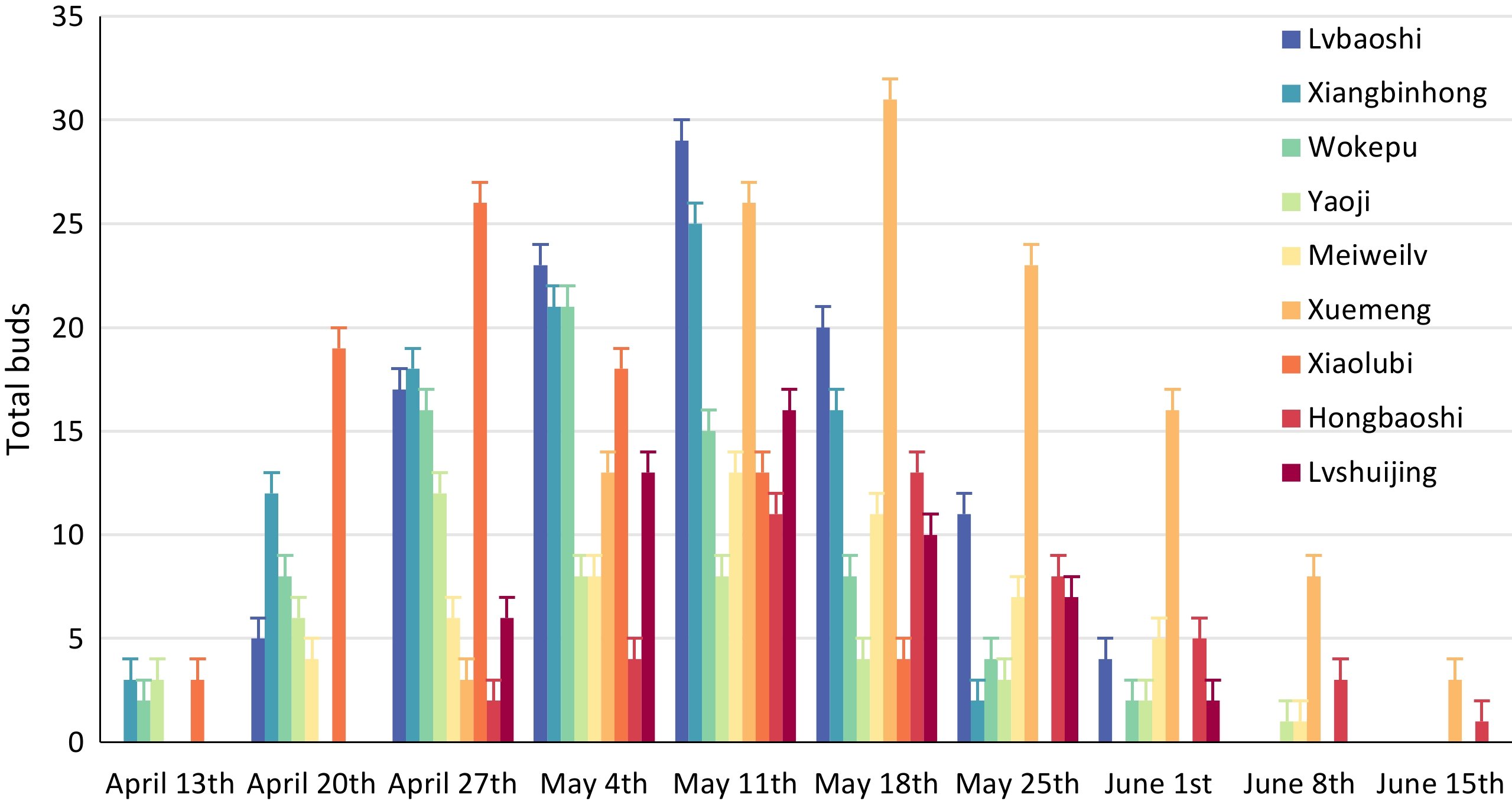
Figure 5.
Comparison of the budding phenology of the finger lime varieties.
-

Figure 6.
Phenology of fruiting in the nine finger lime varieties.
-
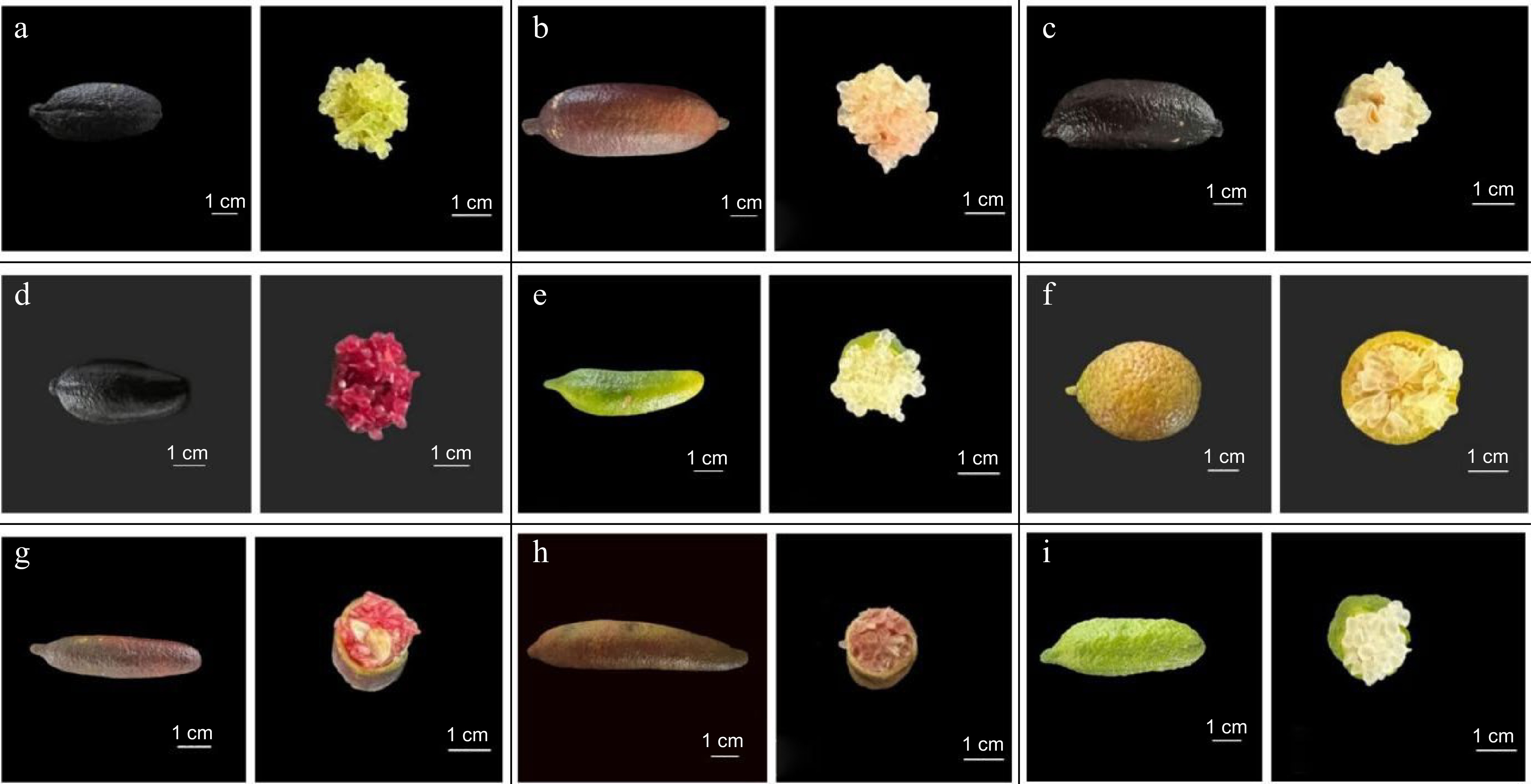
Figure 7.
Comparison of the pulp color of the finger lime varieties. (a) Lvbaoshi, (b) Xiangbinhong, (c) Wokepu, (d) Yaoji, (e) Meiweilv, (f) Xuemeng, (g) Xiaolubi, (h) Hongbaoshi, (i) Lvshuijing.
-
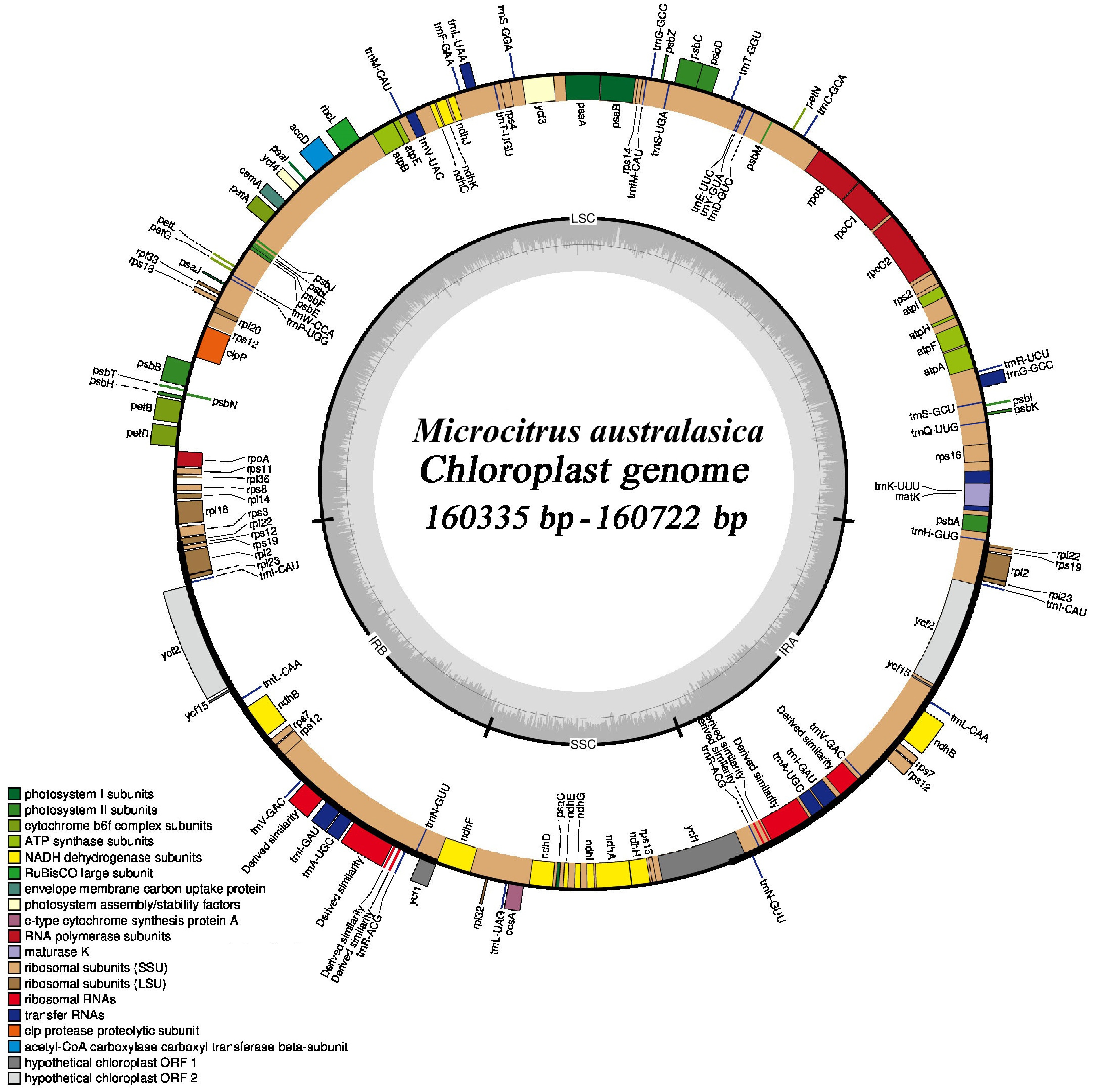
Figure 8.
Chloroplast genome of finger lime. In a circular form, genes inside the outer ring are transcribed clockwise and genes outside the ring are transcribed counterclockwise. The gray area in the inner circle indicates the GC content of the chloroplast genome. Different colors indicate different functional genes.
-

Figure 9.
ML (Maximum Likelihood) and BI (Bayesian Inference) trees constructed based on whole chloroplast genome dataset. ★ Indicates that the support value is 100%/1.0, the number near the node indicates the support value of 60% and 0.6 or more obtained by the analysis, and different colors represent different branches of the family.
-
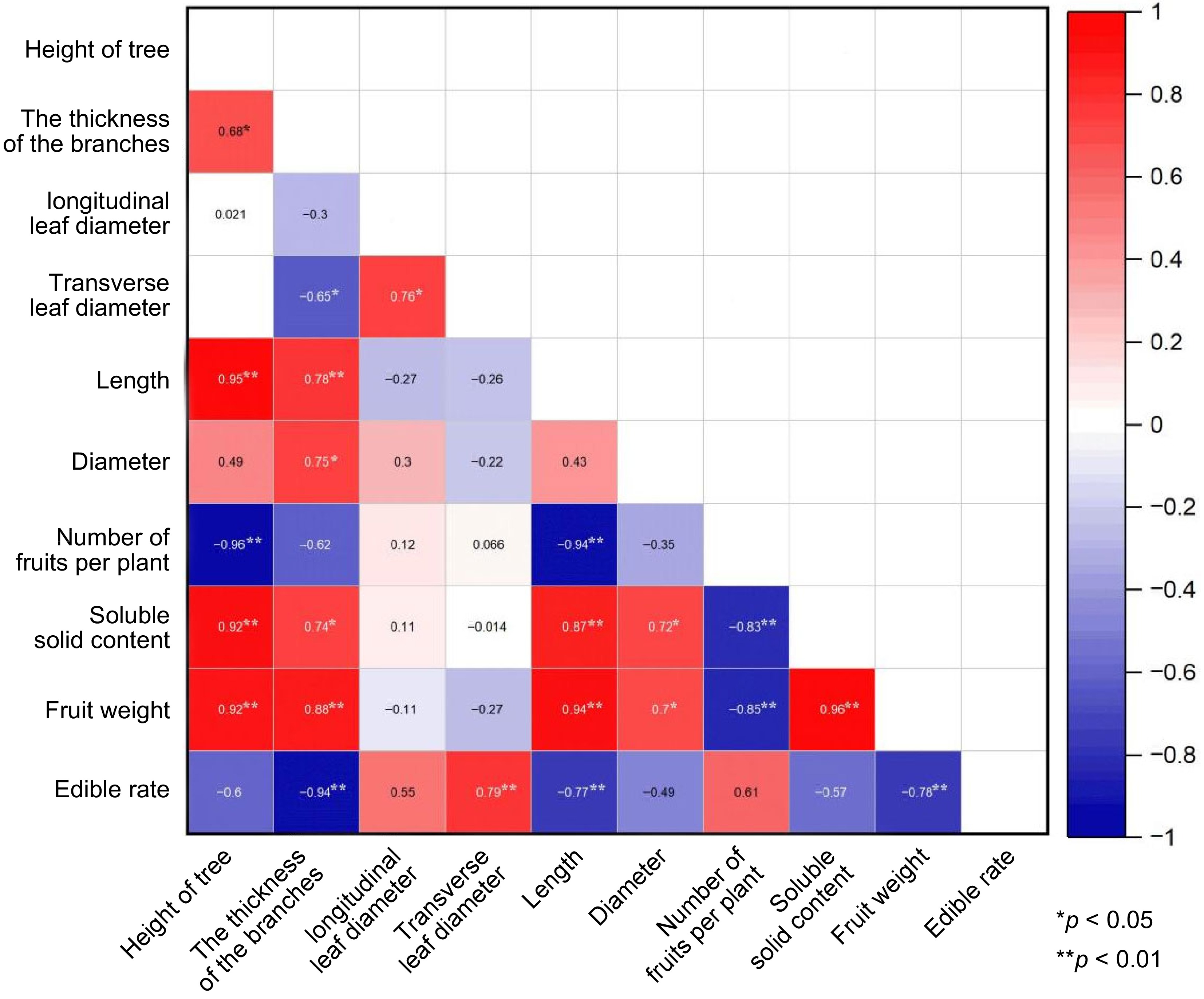
Figure 10.
Correlation analysis of some observed traits of finger limes. * p < 0.05 is considered significant. ** p < 0.01 is considered highly significant.
-
Variety Tree height (cm) Trunk thickness (cm) Branch thickness (mm) Distance between thorns (mm) No. of thorns per branch Spine length (mm) Lvbaoshi 126 15.8 4.9 18.5 11-18 12.1 Xiangbinhong 161.2 24.6 5.1 20.9 12-20 6.9 Wokepu 200 20.2 6.8 14.5 15-20 10.3 Yaoji 186.2 29.6 5.7 14.7 16-22 7.7 Meiweilv 211.8 21.8 6.0 15.3 18-24 11.3 Xuemeng 146.8 21.6 8.2 21.8 9-14 12.0 Xiaolubi 91.6 20.2 6.4 16.8 12-18 6.4 Hongbaoshi 297 32.6 8.7 20.5 12-17 9.4 Lvshuijing 144 20.2 6.2 17.1 15-19 11.1 Table 1.
Comparison of morphological characteristics of finger lime plants of different varieties.
-
Variety Leaf width
(mm)Leaf length
(mm)Presence
of petioleLvbaoshi 14.6 22.3 Absent Xiangbinhong 15.2 26.6 Absent Wokepu 12.7 22.0 Present Yaoji 12.8 20.6 Present Meiweilv 12.4 22.9 Absent Xuemeng 11.3 25.9 Present Xiaolubi 7.6 13.5 Absent Hongbaoshi 13.5 23.2 Absent Lvshuijing 10.5 22.5 Absent Table 2.
Comparison of the leaf morphology of different finger lime varieties.
-
Variety Bud
length
(mm)Petal
length
(mm)Style
length
(mm)Position relationship between anther and stigma (mm) Lvbaoshi 5.5 8.5 8.1 0.13−0.41 Xiangbinhong 6.3 8.3 8.3 0.11−0.26 Wokepu 5.7 8.3 8.1 0.23−0.42 Yaoji 6.1 8.4 8.4 0.12−0.21 Meiweilv 6.1 8.4 8.1 0.23−0.48 Xuemeng 5.9 8.0 7.8 −0.21−0.24 Xiaolubi 5.3 7.7 7.4 0.28−0.42 Hongbaoshi 6.1 8.5 8.2 0.36−0.58 Lvshuijing 6.0 8.3 8.3 0.12−0.23 The position relationship between anther and stigma is the minimum and maximum value, and other values are the average values of 30 samples randomly selected from five fruit trees. Table 3.
Comparison of morphological characteristics of finger lime flowers of different varieties.
-
Variety Fruit color Fruit shape Whether the pericarp oil cell is obvious Whether
the tail
protrudesLvbaoshi Dark green Cylindrical Not obvious No Xiangbinhong Black red Elongated bar Not obvious Yes Wokepu Dark green Elongated bar Obvious Yes Yaoji Black Oval Obvious No Meiweilv Green Shallow arched Obvious Yes Xuemeng Emerald green Spherical Obvious No Xiaolubi Dark green Oval Obvious No Hongbaoshi Emerald green Oval Obvious No Lvshuijing Emerald green Elongated bar Obvious Yes Table 4.
Comparison of morphological characteristics of finger lime fruit from different varieties.
-
Variety Total buds Total flowers Flowering rate Lvbaoshi 109 85 78.0% Xiangbinhong 97 89 91.8% Wokepu 76 64 84.2% Yaoji 47 45 95.7% Meiweilv 55 46 83.6% Xuemeng 123 88 71.5% Xiaolubi 83 76 91.6% Hongbaoshi 47 43 91.5% Lvshuijing 54 49 90.7% Table 5.
Flowering of different finger lime varieties.
-
Variety Fruit set rate Fruit ripening
rateNumber of fruit
per plantLvbaoshi 94.1% 96.3% 77 Xiangbinhong 93.3% 95.2% 79 Wokepu 79.7% 90.2% 46 Yaoji 80.0% 91.7% 33 Meiweilv 73.9% 94.1% 32 Xuemeng 97.7% 95.3% 82 Xiaolubi 94.7% 95.8% 69 Hongbaoshi 88.4% 89.5% 34 Lvshuijing 71.4% 91.4% 32 Table 6.
Set rates, ripening rates, and total fruit production of the finger lime varieties.
-
Variety Length (mm) Diameter (mm) Fruit weight (g) Peel weight (g) Flesh color Av. no. of seeds Tightness of peel Lvbaoshi 41.0 17.1 8.8 2.1 Green 9.6 Loose Xiangbinhong 43.6 15.8 8.6 2.3 powder 15.0 Tight Wokepu 61.3 17.8 14.0 6.0 White 13.0 Tight Yaoji 48.7 18.2 10.7 3.3 Red 19.4 Loose Meiweilv 58.4 13.4 6.3 2.8 Green 7.4 Tight Xuemeng 32.2 25.7 13.5 6.1 Yellow 3.0 Loose Xiaolubi 48.6 11.3 4.7 2.4 Red 8.4 Tight Hongbaoshi 106.8 22.6 29.3 16.1 powder 14.6 Loose Lvshuijing 58.7 19.4 10.7 5.0 White 11.6 Loose Table 7.
Physical parameters of the finger lime varieties.
-
Variety Ease of juicing Sugar Juice pH Valve number Edible portion (%) Lvbaoshi Easy 10.9% 2.33 6 73.1% Xiangbinhong Easy 17.4% 2.29 5 69.6% Wokepu Easy 15.7% 2.24 6 54.7% Yaoji Easy 12.7% 2.49 5 66.6% Meiweilv Easy 20.7% 2.84 6 51.1% Xuemeng Difficult 13.1% 2.54 8 52.1% Xiaolubi Difficult 28.5% 3.95 6 42.3% Hongbaoshi Difficult 11.3% 2.71 4 44.5% Lvshuijing Easy 14.5% 2.35 6 51.7% Table 8.
Fruit flavor evaluation of the finger lime varieties.
Figures
(10)
Tables
(8)